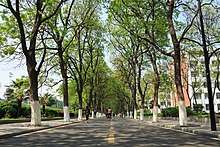Tree paint
Tree paint, also known as wound dressing, is any substance applied to damaged surfaces of a tree intended to improve the health of the tree. It is commonly applied after pruning, or at locations where the tree bark has been damaged.[1]
Description

Tree guard paints are sold as organic & non-organic products. Some gardeners use a light colored interior latex-based paint diluted with 50% water.
Both Sunburn and Sun scald cause the tree's bark to crack and/ or die—resulting in additional stress which get compounded by insects and parasites that enter the barkless wood—an invasion that will ultimately shorten the tree's life. Tree paint protects against this.
Some tree paint, depending on ingredients, also protect against insects and rodents. For example, neem oil, which has been used by Indian farmers for thousands of years, for many uses, including a natural insect repellant and insecticide. Unlike other oils, plants sprayed with diluted neem oil repel insects from plants, smothers those in contact with the neem spray, and ultimately kills most insects that ingest the product within 1–3 days.
Castor oil, which comes from the castor tree seed, and naturally makes everything coated with this product taste horrible and should repel most rodents; such as rats, moles, voles, gophers and rabbits that may gnaw on the tree's bark.[2]
Tree paint may help to prevent disease-carrying insects from entering a wounded tree.[3] Studies have shown that wound dressing must be applied immediately after damage or pruning. Even a delay of three days can be too long.[1]
White tree paint is commonly applied to citrus trees to keep the affected tissues from overheating, as dark-colored paint can raise the surface temperature of the treated tissues. The classic tree paint is black, because it is based on an asphalt emulsion.
Although consumer versions of tree paint may come in spray cans, commercial application may involve paint guns. Tree paint can also applied by brush.
An organic tree paint can be made; it is similar to a brushable mud.
References
- Juzwik, Jennifer, French, D.W., Jeresek, Jon, Overland Spread of the Oak Wilt Fungus in Minnesota, Journal of Arboriculture 11(11): November 1985 323
- http://www.thegardenacademy.com/Organic_Tree_Paint.html
- A Guide to Successful Pruning, Pruning Deciduous Trees